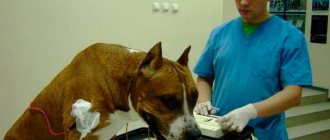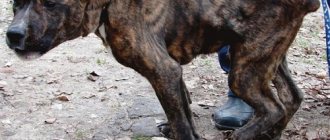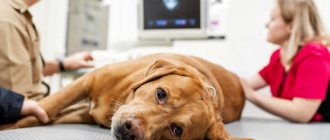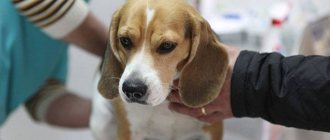Some diseases of the nervous system affect metabolism and can have a serious impact on the dog's behavior. This should not be understood as a nervous reaction to the doorbell or urination as a sign of subordination: such phenomena are eliminated in the learning process. The nervous system in dogs is located literally throughout the body, covering not only the brain and spinal cord, but also the nerve endings of the limbs. Its main functions are receiving and processing information with further sending commands to peripheral areas of the body. Therefore, diseases of the central nervous system can be a consequence of failures of other organ systems.
Paralysis in dogs
Paralysis is a violation of the motor function of one muscle or group of muscles. With this disease, there is no sensitivity in the affected area, and the transmission and execution of commands by the nervous system becomes impossible. The cause of this disorder may be malfunctions of both the central and peripheral nervous systems. Peripheral paralysis is characterized by immobilization of one side of the organ due to injury to nerve tissue.
Central nervous system paralysis often affects paired organs, but can occur in any organ of the animal (face, ears, tail, lower jaw, bladder, rectal muscles). The result of paralysis, as a rule, is its atrophy. This disease is treated successfully at the initial stage and is intense and long-lasting. The causes and methods of treating paralysis are determined by a veterinarian.
Neurological diseases of dogs: treatment at the CC
Many people notice that dogs often “adopt” the behavior of their owners and are distinguished by extremely wide manifestations of individuality in their character. These differences are mainly due to different types of nervous activity, and sometimes the causes of deviations are diseases of the nervous system in domestic dogs.
In order to understand the reasons for certain manifestations of an animal’s behavior, it is necessary to know the causes of the condition, be able to identify the disease in the early stages and understand when individuality ends and the disease begins. Basic knowledge will help you detect the disease at the very beginning and quickly cure your beloved dog.
Diagnosis of discopathy in dogs
Myelography
Diagnosing discopathy is quite easy if you have the appropriate knowledge, experience and equipment from a veterinarian - neurologist.
Source: https://bier-loga.ru/drugoe/nevrologicheskie-zabolevaniya-u-sobak.html
Epilepsy in dogs
A disease of the nervous system characterized by regularly recurring seizures is called epilepsy. According to veterinarians, dog seizures only vaguely resemble epilepsy. They last from a few seconds to several minutes. The attack begins with a fall and convulsive twitching in the air of all limbs. During a seizure, the animal experiences a glazed look and copious salivation. At the end of the attack, the dog may still spin in place for some time, trip over various obstacles, but then return to its normal state. It is noteworthy that most animals feel guilty towards their owners.
Sometimes seizures occur in very frequent series, which leads to death from heart failure, and sometimes there can be several years between them. To date, the causes of epilepsy in dogs have not been established, but it has been noted that only some breeds are prone to this disease.
The causes of seizures in dogs vary widely: brain tumors, poisoning, disease affecting the brain, canine rabies and meningitis. Epileptic seizures are sometimes caused by brain injury, but can also be hereditary - for example, in a golden retriever. In addition to treating the underlying disease, dogs that experience regular seizures should be given anti-convulsant medications - phenobarbital, etc. (as recommended by a veterinarian).
General information
In medicine, neuralgia is usually called nerve damage (more precisely, its inflammation). As a rule, it is accompanied by acute pain in the place where the damage is localized. Neuralgia has several forms. The most famous is inflammation of the trigeminal nerve. This pathology is considered the most common type of the disease we describe, occurring in approximately 50% of cases. Bitches whose age exceeds seven years are most susceptible to it. Males are much less likely to suffer from this disease. What this is connected with is not completely clear. But still, statistics collected all over the world show that such “gender discrimination” actually exists.
As in the case of humans, neuralgia in dogs causes animals a lot of suffering. But, unlike people who can speak, a dog will not be able to tell what exactly and how it hurts. Because of this, the diagnostic process is very difficult. The causes of neuralgia are relatively typical, here are some of them:
- Infectious disease.
- Trauma to the facial part of the skull.
- Severe or regular hypothermia of the body.
- Sick teeth.
- Inflammation of the sinuses, etc.
Particular attention should be paid to infectious pathologies . As a rule, pathogenic microorganisms are not able to overcome the protective sheath of the nerve trunks, but sometimes this happens. This may be the case in cases of particularly serious pathologies, in which the immune system is greatly deteriorated and is no longer able to provide adequate protection for the body. In addition, this can happen with sepsis. However, in this case, inflammation of the nerves is the least of the problems.
Concussion in dogs
The main functions of the skull in a dog, like in a person, are to protect the brain from all kinds of damage. A concussion in an animal can occur as a result of various injuries received from possible falls from a height, road traffic accidents, or severe blows to the head. This condition is characterized by temporary loss of consciousness and disruption of brain function; strabismus, vomiting and dizziness may occur.
Often the animal has a staggering gait and poor coordination of movements. If the injury is not severe, then after a maximum of three days of rest the dog returns to normal. Due to a strong blow, blood vessels sometimes burst, which leads to hemorrhage in the brain. If the hemorrhage is extensive, it can lead to the death of the animal. In such cases, examination by a veterinarian is mandatory.
Therapeutic techniques
How is the treatment carried out? To prescribe certain medications, the veterinarian will have to determine not only the form of the neurology, but also the cause of its occurrence. It is highly not recommended to treat this disease yourself, since choosing medications on your own can only worsen the situation. Drugs and treatment methods prescribed for neuralgia:
- Painkillers with anti-inflammatory effect . Very often, veterinarians prescribe anti-inflammatory corticosteroids. They do an excellent job with the pathology we describe and its manifestations, but we must remember that in some cases (inflammation of the sciatic nerve) the pet will take a long time to be treated. Corticosteroids cannot be used for such a long time, as they can provoke the development of fungal infections.
- Anticonvulsants . They are prescribed only in particularly serious cases, when convulsive seizures develop from severe pain.
- Analgesics and anesthetics . An integral part of the treatment of neuralgia.
- Physiotherapy . This technique, undeservedly forgotten by many veterinarians, can greatly help the owner of a sick dog.
- Surgical intervention if it is impossible to cope with the disease using medication and physiotherapy.
- Acupuncture . Until relatively recently, the latter method was perceived by many as “quackery,” but the actual practice of its use clearly proves that this is not the case at all.
Thus, neuralgia is an extremely painful pathology. Only an experienced specialist can treat it. If you notice that your beloved dog is behaving in some strange way, he is clearly suffering from severe pain, you should not engage in “witchcraft”: urgently show him to a veterinary specialist. He can certainly help.
Inflammation of the spinal cord or brain in dogs
The causes of inflammation of the spinal cord or brain can be complications after various infectious diseases (rabies, false rabies, encephalitis) or injuries with subsequent inflammatory processes.
Symptoms of the disease are various disorders of consciousness (aggressiveness, depression, inadequate reaction to what is happening), as well as impaired motor function of the animal’s body. The recovery process is long, the consequences of the disease can be of varying severity, from blindness and deafness to paralysis of individual limbs. When assessing the severity of damage to the body, it is often necessary to make a decision about the advisability of continuing the dog’s life.
Nervous breakdowns can be triggered by a condition of the spinal cord or the nerves that connect to it. In breeds with long backs, slippage of the intervertebral disc occurs. The vertebrae are separated by shock-absorbing soft cartilage discs that are held in place by ligaments. When the ligaments weaken, the disc moves out of place and compresses the spinal cord. This causes back pain, paralyzes the hind legs, and sometimes all four legs (if the disc is in the cervical region).
Symptoms of the disease
The disease has many manifestations. They directly depend on the temperament and character of the animal. The nature of the manifestations of neurosis differs in a number of main features:
- The animal constantly experiences fear, which periodically has a panic character;
- The dog may also be in complete apathy. At such moments she does not react to external stimuli. The animal is indifferent to everything that happens around it;
- Aggressive behavior is considered the most dangerous manifestation. At such moments, a real monster can be born. He attacks all people and can harm even his own owner.
We recommend reading: Coronavirus Gastroenteritis in Cats What Is It
Neurosis in a dog must be recognized promptly. It is dangerous for the animal and the people around it. If you suspect the presence of the disease, you should visit a pediatrician. He should be informed of any recent contact the dog has had with other animals. If such a situation occurred, the doctor will take a rabies test. In this way, it will be possible to confirm or refute the diagnosis of a pet.
Quite often, fear is a characteristic feature of small breed dogs, for example, a Yorkie or a toy terrier. In this case, neurotic behavior is considered normal. You should not expect much courage from the pocket breed. In this case, the main task of the owners is to provide comfortable conditions for the existence of their pet. Apathy does not always need to be treated. The situation may indicate excessive fatigue of the animal. Indifference to everything around is observed in the case of taking sedatives or antipsychotic drugs.
Treatment options
Treatment should be selected by a pediatrician if the symptoms indicate a serious nervous disorder:
- Constant fear indicates an animal's anxiety. The dog may shrink from every loud sound or knock. Even a bird or butterfly that is far away can cause a negative reaction. This situation is in some cases accompanied by aggressive behavior. The animal begins to actively rush at people or react to objects. Dogs that have been adopted from a shelter by their owners are often characterized by this behavior at first. Thanks to the owner's care, a negative situation will be avoided. Neurosis can cause loneliness. It is recommended to pay enough attention to your pets. It is not recommended to leave your pet unattended or alone in the house for a long time. The situation can lead to panic attacks.
- Each dog has different manifestations of apathy. Some of them just sit, while others carefully follow a static or moving object. Quite often, such a manifestation abruptly gives way to unbridled activity. The dog begins to play with frantic activity, which can lead him to complete exhaustion. After such a pastime, he falls exhausted to the ground and cannot move.
- Aggression is expressed not only in the event of a direct attack. Sometimes in this way the animal tries to begin to dominate. The manifestation is directed towards dogs or people. Scientists have been able to prove that in this way dogs are desperately trying to attract the attention of their owners after the birth of their child. Unfortunately, the situation is dangerous and can pose a real threat to the baby’s life. In this case, it is strictly not recommended to ignore the demands for attention. It is important to seek help from a veterinarian in time, who can choose an adequate course of treatment.
Pathology must be treated without fail. The dog should organize conditions in which the likelihood of stress will be minimized. You cannot count on self-healing in this matter. It is dangerous if the neurosis has reached the final stage, because in this case the animal becomes completely inadequate.
The veterinarian will be able to select medications that will help restore psychological balance. Treatment will not give results if the reliable cause of the disease is not established. The dog needs to establish the process of nutrition and rest. Additionally, it is recommended to protect him from stressful situations. Quite often, this treatment option gives good results without the use of drugs.
The love and care of a beloved owner works wonders. You must try to give your pet a lot of attention and affection. Thanks to this, a positive result will be achieved within a short period of time. We can cure neurosis. The main thing is to seek help from a veterinarian in time.
Today, neurosis is a common medical term that is actively used in everyday life. Not every person has thought about the meaning of the term. From a scientific point of view, it has an accurate decoding, which gives a complete picture of the pathological condition. The disease develops against the background of prolonged exposure of the animal to a stressful situation. At the same time, the work of the nervous system is not carried out in the required mode, but only depletes the body. Against this background, neuroses lead to negative changes in the dog’s behavior.
Video text
Surgical and neurological pathologies in small breed dogs
Lecturer: Yagnikov Sergey Aleksandrovich – Doctor of Veterinary Sciences
Veterinary video lecture from Pedigree® is devoted to surgical and neurological pathologies in small breed dogs
The video lecture is given by Sergey Aleksandrovich Yagnikov - Doctor of Veterinary Sciences, Professor of the Department of Clinical Veterinary Medicine at the Peoples' Friendship University of Russia, head of a network of veterinary clinics, laureate of the Association of Practicing Veterinarians "Golden Scalpel" in the nomination "For scientific contribution to the development of veterinary medicine", as well as the author textbooks, methodological recommendations and numerous scientific publications.
The video lecture discusses the following issues: 1) Fractures in dogs of dwarf breeds: typical complications, causes of nonunion of fragments, standards of surgical treatment. A radiographic classification is presented that allows one to determine the prognosis for fusion of fragments, as well as the methodology of osteosynthesis with plates and a bilateral single-plane external fixator. 2) Surgical treatment and diagnosis of anterior cruciate ligament rupture associated with medial patellar dislocation in toy breed dogs. 3) Neurological diseases of dogs of dwarf breeds. Diagnosis and treatment of atlanto-axial instability, intervertebral disc herniation, lordosis, kyphosis of the thoracic spinal column, Chiari syndrome.
®/™ Trademarks © Mars, Incorporated 2021.
Category/ Category Animals| Animals
License/License Standard License YouTube/Standard
Lecturer: Yagnikov Sergey Aleksandrovich – Doctor of Veterinary Sciences











